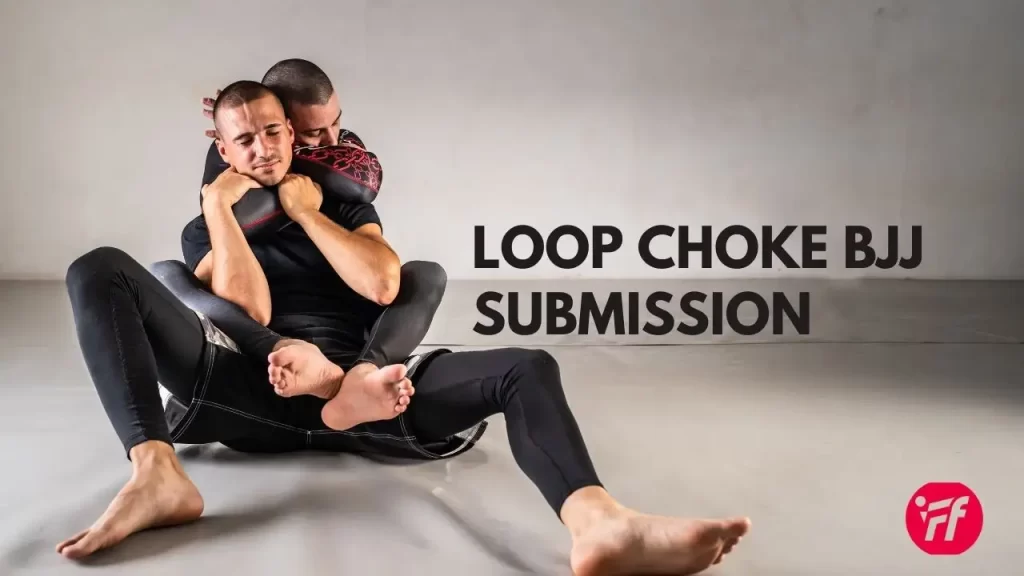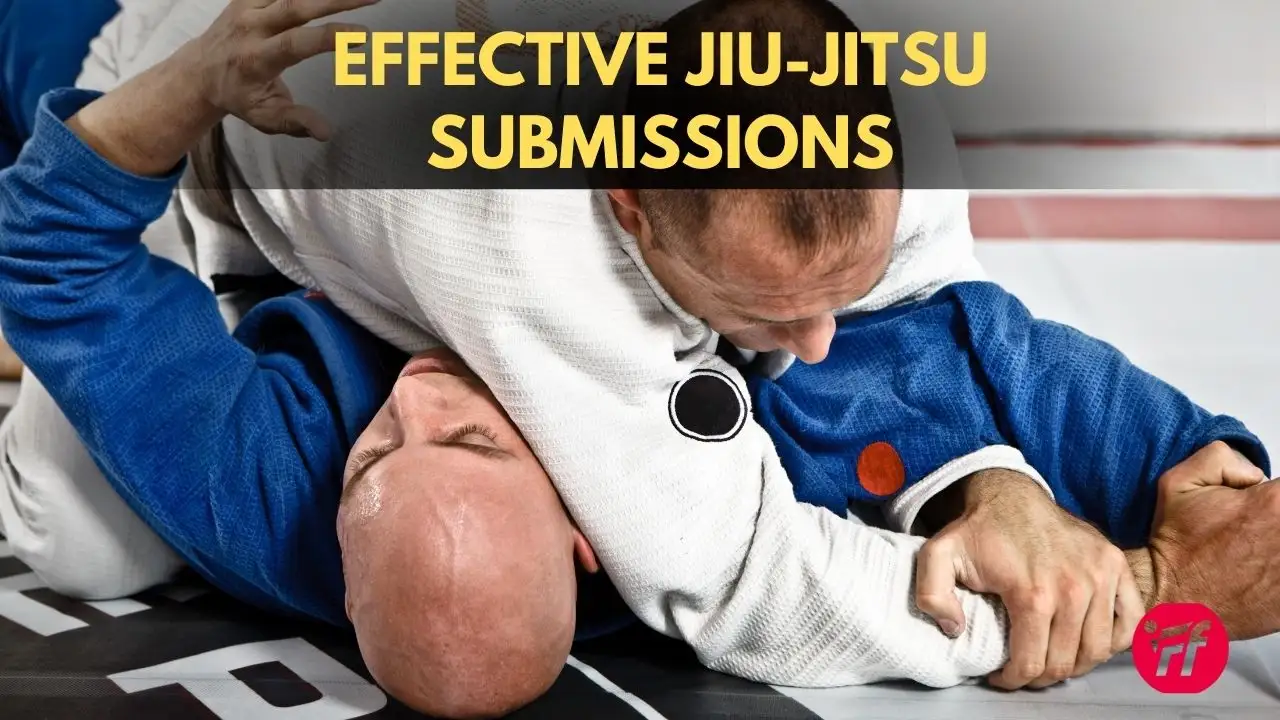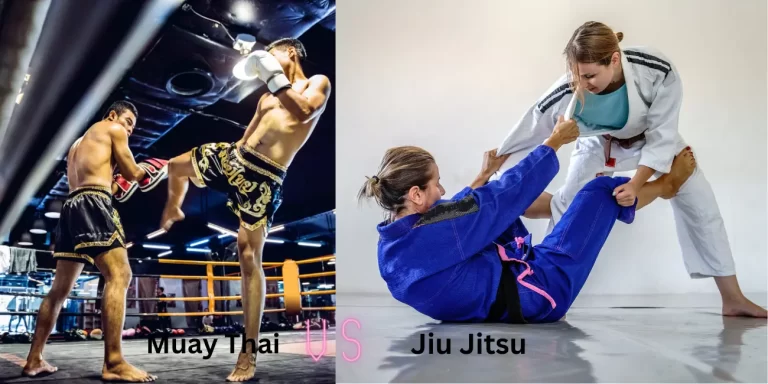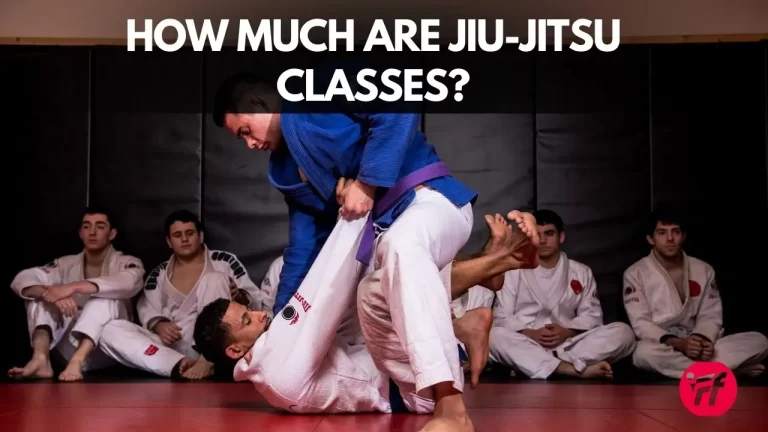Top 15 Effective Jiu-Jitsu Submissions
Brazilian Jiu-Jitsu (BJJ) is renowned for its diverse array of submission techniques that enable practitioners to control and submit opponents effectively. In this collection of instructional guides, BJJ World Champions from the Evolve Fight Team demonstrate key details and variations of powerful chokes and submissions.
The highly effective submissions are;
- Bow and Arrow Choke
- Rear Naked Choke
- Triangle Choke
- Cross Choke
- Guillotine Choke
- North-South Choke
- Armbar
- Kimura
- Heel Hook
- Arm Triangle Choke
- D’Arce Choke
- Loop Choke
- Paper Cutter Choke
- Americana
- Loop Choke.
Let’s dive into the confusion of these techniques, each showcased by accomplished practitioners.
15 Most Effective Jiu-Jitsu Submissions

Discover the pinnacle of Jiu-Jitsu prowess with the 15 most effective Submissions, revealed by experts Teco Shinzato, Almiro Barros, and Leandro Issa.
1. Bow And Arrow Choke
The bow and arrow choke stands out as a formidable technique in GI competitions. BJJ World Champion Teco Shinzato illustrates how to utilize the opponent’s collar to strangle them from the top position. This technique gets its name from the practitioner’s extension, reminiscent of drawing and firing an arrow from a bow.
2. Rear Naked Choke
Considered the highest percentage move from the back, the Rear Naked Choke (RNC) involves wrapping your arm around the opponent’s neck to restrict air and blood flow.
Teco Shinzato provides a comprehensive demonstration of the critical steps involved in executing this highly effective technique.
3. Triangle Choke
The triangle choke, a quintessential BJJ submission, showcases the power of leverage over size and strength. BJJ black belt Almiro Barros demonstrates five effective variations of the triangle choke, highlighting its versatility in controlling and submitting opponents.
4. Cross Choke

Teco Shinzato exemplifies the execution of the cross-collar choke from the mount position, a technique favored by multiple-time world champion Roger Gracie.
This submission involves using the opponent’s collar against them by crossing arms and removing gi slack, thereby restricting blood flow and delivering a powerful top-position attack.
5. Armbar
An excellent submission applicable in both sports BJJ and MMA, the armbar isolates and hyperextends the arm beyond its natural range of motion.
Teco Shinzato shares key details to ensure a tight and effective armbar, emphasizing the importance of using legs, hips, and arms in the execution.
6. Kimura
BJJ Champion Fabio Da Mata showcases the basic kimura from half guard, emphasizing its versatility as a bent joint lock applicable from various positions.
The kimura’s high percentage of success stems from its availability, allowing practitioners to capitalize on opponents’ mistakes for sweeps and transitions.
7. Guillotine Choke
Leandro “Brodinho” Issa, a Brazilian Jiu-Jitsu World Champion and ONE Superstar demonstrates the guillotine choke, a potent submission often applied when opponents turtle up or from the front headlock position.
Issa provides insights into the execution of a basic guillotine choke, showcasing its versatility in various scenarios.
8. Heel Hook
A heel hook is a submission technique commonly used in grappling martial arts, particularly in Brazilian Jiu-Jitsu (BJJ) and submission wrestling. It is a joint lock that targets the ankle and, more specifically, the ligaments of the knee joint.
The heel hook involves manipulating the foot and ankle to apply torque and pressure on the opponent’s knee, potentially causing severe discomfort or injury.
The basic mechanics of a heel hook involve trapping the opponent’s leg with your legs, securing control of their foot, and then twisting the foot relative to the leg. This twisting motion puts stress on the knee’s ligaments, particularly the medial collateral ligament (MCL) and the anterior cruciate ligament (ACL).
If applied with sufficient force and speed, a heel hook can lead to hyperextension or tearing of these ligaments, resulting in serious injury.
9. Arm Triangle Choke
BJJ World Champion Leandro “Brodinho” Issa demonstrates the execution of the arm triangle choke from the turtle position. This submission involves trapping one of your opponent’s arms inside, using their shoulder to restrict blood flow to the neck, while applying pressure with your arm on the other side.
Issa’s video provides a step-by-step guide to mastering this effective choke from a defensive position.
10. D’Arce Choke
This submission is applied when the opponent is on the defensive, involving shooting your arm under theirs and locking it against the neck.
Gracie highlights the dynamic nature of the D’Arce choke, with the finish varying based on the relative body positions, showcasing a combination of a choke and crank for a powerful and effective outcome.
11. North-South choke
The north-south choke is a grappling technique that involves utilizing the practitioner’s bicep against the opponent’s neck, accompanied by pressure from the practitioner’s back on the opponent’s head. This maneuver is executed from the north-south position, a variant of side control where both participants’ feet point in opposite directions.
Initiated from the side control position, the execution of the north-south choke demands precision in its finer details, making it challenging for some practitioners to complete successfully.
To enhance your proficiency in finishing this choke, consider incorporating insights from Marcelo Garcia, a renowned expert in the north-south choke technique.
12. Loop Choke

The loop choke is a collar-based submission technique where the practitioner employs their free arm to encircle the opponent’s neck, finalizing the choke.
Frequently utilized as a defensive response to a guard pass, this technique exhibits versatility by being applicable from various positions such as open guard, closed guard, side control, and even from the turtle position.
13. Paper Cutter Choke
The paper cutter choke is a collar-based submission executed from top-side control, where the practitioner utilizes their forearm to apply pressure across the opponent’s neck.
Renowned for its deceptive setup, this choke often catches opponents off guard, earning a reputation for its element of surprise.
14. Americana
The Americana is a foundational Brazilian Jiu-Jitsu (BJJ) submission that focuses on manipulating the opponent’s shoulder.
Executing a successful Americana involves the practitioner lifting the opponent’s arm and bending the elbow toward the ceiling, all the while maintaining control over the opponent’s body to restrict their movement.
This submission is frequently initiated from mount or side control positions, showcasing its adaptability as it can be effectively employed in various grappling scenarios.
15. Armbar
The armbar is a fundamental yet potent submission technique designed to hyperextend the opponent’s elbow joint. This maneuver involves the adept use of the practitioner’s legs, hips, and hands to isolate the opponent’s arm while maintaining control over their body.
Widely regarded as one of the initial submissions taught to Brazilian Jiu-Jitsu practitioners, the armbar showcases remarkable versatility in its application.
Why Are Submissions Important?
In BJJ culture, securing submissions is a coveted achievement during sparring. Their significance lies in both individual and collective aspects, contributing to the core identity of the art and is likely to remain integral to its culture.
Frequently Asked Questions
Are submissions dangerous in Brazilian Jiu-Jitsu?
While submissions can cause discomfort, injury risk is mitigated by controlled training environments, proper technique, and practitioners’ awareness. It’s crucial to prioritize safety, tap early in training, and communicate with training partners.
Can anyone learn Jiu-Jitsu submissions, regardless of size or strength?
Yes, the beauty of BJJ lies in its emphasis on leverage and technique over size and strength. Practitioners of all sizes can learn and apply submissions effectively with proper instruction, practice, and understanding of leverage.
How long does it take to master Jiu-Jitsu submissions?
Mastery is a continuous journey, but basic submissions can be learned relatively quickly. Proficiency depends on consistent training, individual aptitude, and the complexity of the techniques. Patience and dedication are essential.
Final Words
Brazilian Jiu-Jitsu submissions are a cornerstone of the art, offering practitioners a diverse toolkit for controlling and submitting opponents.
From chokes like the Bow and Arrow to joint locks like the Armbar, each technique requires a combination of skill, exploration, and finesse.
Safety, respect for training partners, and a commitment to continuous improvement are essential elements of a practitioner’s journey in mastering these submissions.
Whether for sport, self-defense, or personal growth, the study of Jiu-Jitsu submissions provides a lifelong pursuit of knowledge and skill development.







